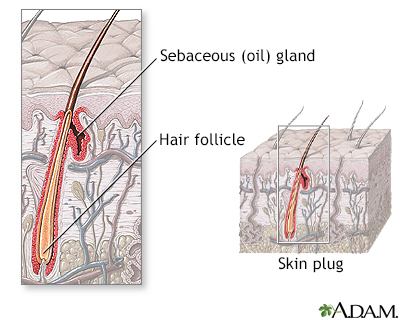Trichorrhexis nodosa
Hair shaft fracture; Brittle hair; Fragile hair; Hair breakage
Trichorrhexis nodosa is a common hair problem in which thickened or weak points (nodes) along the hair shaft cause your hair to break off easily.

At the base of the hair follicle are sensory nerve fibers that wrap around each hair bulb. Bending the hair stimulates the nerve endings allowing a person to feel that the hair has been moved. One of the main functions of hair is to act as a sensitive touch receptor. Sebaceous glands are also associated with each hair follicle that produce an oily secretion to help condition the hair and surrounding skin.
Causes
Trichorrhexis nodosa can be an inherited condition.
The condition may be triggered by things such as blow-drying, ironing the hair, over-brushing, perming, or excessive chemical use.
In some cases, trichorrhexis nodosa is caused by an underlying disorder, including very rare ones, such as:
- Thyroid gland not making enough thyroid hormone (hypothyroidism)
- Buildup of ammonia in the body (argininosuccinic aciduria)
- Iron deficiency
- Menkes syndrome (Menkes kinky hair syndrome)
- Ectodermal dysplasia (a group of conditions in which there is abnormal development of the skin, hair, nails, teeth, or sweat glands
- Trichothiodystrophy (inherited disorder that causes brittle hair, skin problems, and intellectual disability)
- Biotin deficiency (inherited disorder in which the body is not able to use biotin, a substance needed for hair growth)
Symptoms
Your hair may break easily or it may appear like it is not growing.
In African Americans, looking at the scalp area using a microscope shows that the hair breaks off at the scalp area before it grows long.
In other people, the problem often appears at the end of a hair shaft in the form of split ends, thinning hair, and hair tips that look white.
Exams and Tests
Your health care provider will examine your hair and scalp. Some of your hairs will be checked under a microscope or with a special magnifier usually used by skin specialists.
Blood tests may be ordered to check for anemia, thyroid disease, and other conditions.
Treatment
If you have a disorder that is causing trichorrhexis nodosa, it will be treated if possible.
Your provider may recommend measures to reduce damage to your hair such as:
- Gentle brushing with a soft brush instead of aggressive brushing or ratting
- Avoiding harsh chemicals such as those used in straightening compounds and perms
- Not using a very hot hair dryer for long periods and not ironing the hair
- Using a gentle shampoo and a hair conditioner
Outlook (Prognosis)
Improving grooming techniques and avoiding products that damage hair will help correct the problem.
This condition is not dangerous, but may affect a person's self-esteem.
When to Contact a Medical Professional
Contact your provider if symptoms do not improve with changes in grooming and other home-care measures.
References
James WD. Diseases of the skin appendages. In: James WD, ed. Andrews' Diseases of the Skin: Clinical Dermatology. 14th ed. Philadelphia, PA: Elsevier; 2026:chap 28.
Rudnicka L, Stefanato CM. Alopecias. In: Bolognia JL, Schaffer JV, Cerroni L, eds. Dermatology. 5th ed. Philadelphia, PA: Elsevier; 2025:chap 69.
Version Info
Last reviewed on: 4/1/2025
Reviewed by: Elika Hoss, MD, Assistant Professor of Dermatology, Mayo Clinic, Scottsdale, AZ. Also reviewed by David C. Dugdale, MD, Medical Director, Brenda Conaway, Editorial Director, and the A.D.A.M. Editorial team.
